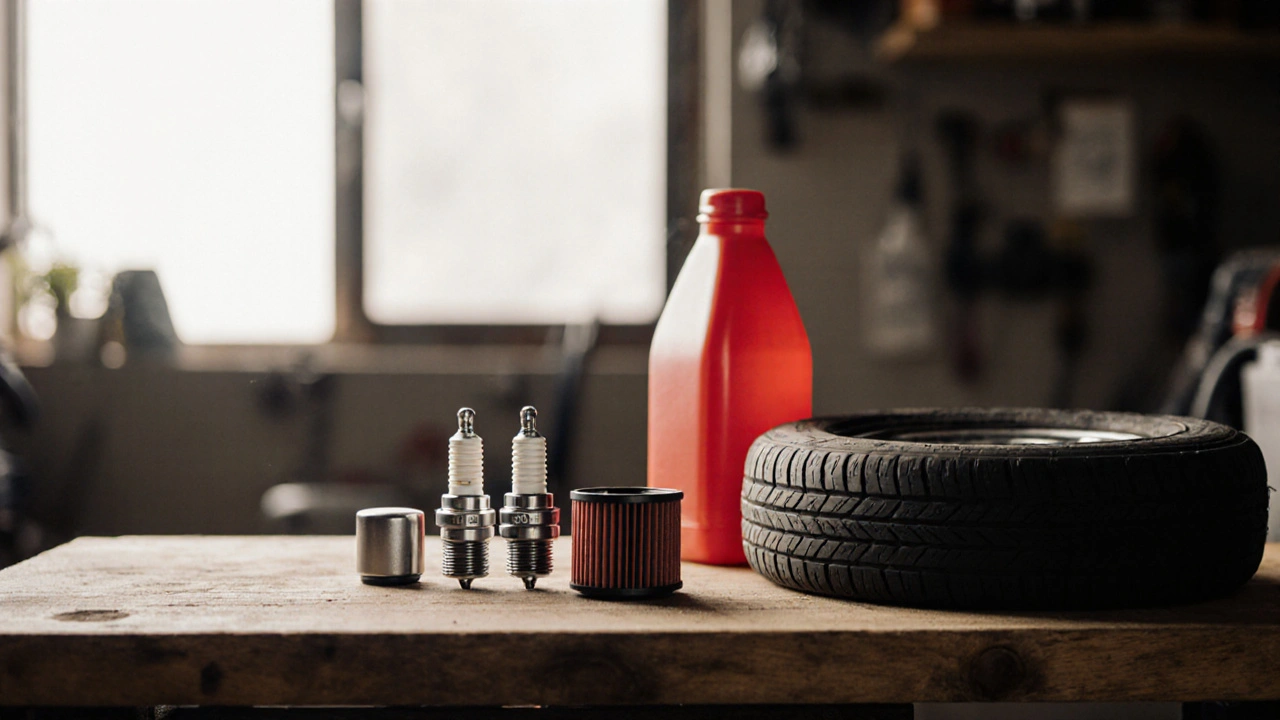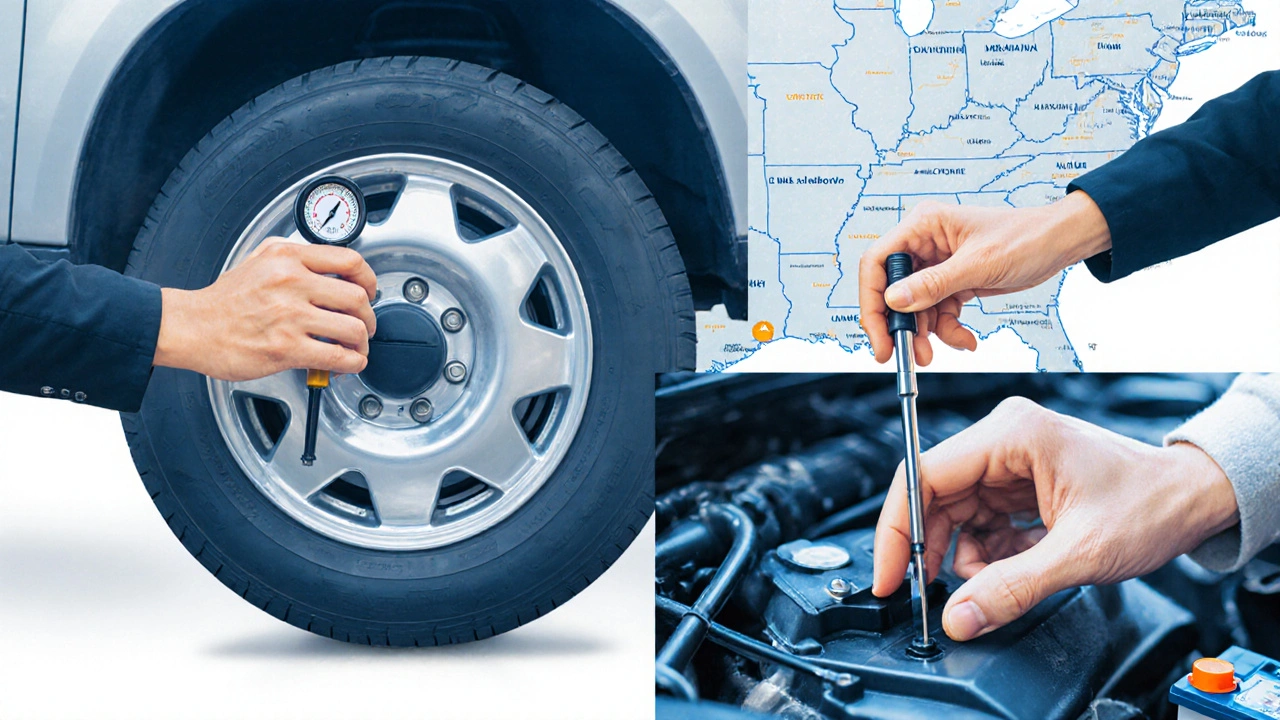Tire Tread Depth Calculator
Check Your Tire Health
Enter your tire's current tread depth (in 32nds of an inch) to determine remaining lifespan and maintenance needs.
When you picture a perfect road trip, you see endless highways, scenic stops, and a playlist that never ends. What you rarely see are the car parts the mechanical components that keep your vehicle moving safely and comfortably doing their silent work. Understanding which parts matter most can mean the difference between a hassle‑free ride and a roadside breakdown.
Why Certain Parts Are Critical for Long Drives
On a long journey, every component is tested more intensely than during a daily commute. Heat builds up, loads increase, and wear compounds faster. The parts that endure the most stress-like the engine, brakes, tires, and suspension-become the unsung heroes of a smooth trip.
Engine: The Heartbeat of Your Adventure
The engine converts fuel into power. If it falters, everything else stops. Regular oil changes, air filter checks, and spark plug inspections are cheap safeguards that keep the engine humming.
- Oil quality: Use the grade recommended in your owner’s manual; synthetic blends last longer under high‑temp conditions.
- Air filter: Replace every 12,000‑15,000 miles or sooner if you drive dusty roads.
- Spark plugs: Worn plugs cause misfires and can reduce fuel efficiency by up to 5%.
Skipping these checks often leads to overheating, loss of power, or, in worst cases, a seized engine.
Transmission: Delivering Power Smoothly
Whether you have an automatic or manual, the transmission’s job is to shift power to the wheels at the right moment. A fluid that’s dirty or low can cause harsh shifting, especially when climbing steep grades.
- Check fluid level and color monthly on trips longer than 500 miles.
- For automatics, replace fluid every 60,000‑100,000 miles depending on manufacturer guidance.
- Manual drivers should watch for clutch slippage; a burning smell means it’s time for a replacement.
A well‑maintained transmission ensures your vehicle accelerates predictably, reducing driver fatigue.
Brakes: The Safety Net
Braking performance is non‑negotiable. On long descents or in wet conditions, brake fade can be deadly. Inspect pads, rotors, and brake fluid before you set off.
- Brake pads: Replace when thickness reaches 3mm; thinner pads increase stopping distance.
- Rotors: Look for deep grooves or warping-both cause pulsation.
- Brake fluid: Change every two years; moisture absorption reduces boiling point.
Remember, a quick stop isn’t just about the brakes themselves but also about tire grip, which brings us to the next hero.

Tires: The Only Contact Point with the Road
Tires wear out faster on long trips due to higher mileage and heat buildup. Proper inflation, rotation, and tread depth are key.
| Condition | Typical Lifespan | Warning Sign |
|---|---|---|
| All‑season | 45,000‑55,000mi | Cracks in sidewall |
| Performance | 30,000‑40,000mi | Reduced tread depth (<6/32") |
| Winter | 35,000‑45,000mi | Bulges or uneven wear |
Check pressure before each leg of the trip; a 2‑psi drop can affect fuel economy and handling.
Suspension: Comfort and Control
A sturdy suspension soaks up bumps and keeps tires planted. Worn shocks or struts lead to excessive body roll and uneven tire wear.
- Shocks/struts: Replace every 50,000‑70,000mi or if you hear clunking over potholes.
- Control arms: Inspect bushings for cracks; loose arms cause steering wobble.
- Wheel alignment: Get a professional check after hitting a curb or after a tire swap.
When the suspension works right, you feel the road’s rhythm instead of its harshness.
Battery: Powering All the Electronics
Modern cars rely on the battery for everything from ignition to infotainment. A weak battery might start fine but can drop voltage under high load, dimming lights or causing the engine to stall.
- Test voltage with a multimeter; healthy cells read 12.6V at rest.
- Clean terminals to prevent corrosion-especially after rainy drives.
- Replace the battery every 4‑5 years or when the cranking speed slows.
A fresh battery ensures you never miss a turn‑by‑turn instruction because the GPS died mid‑route.

Cooling System: Keeping Temperatures in Check
Engine overheating is a nightmare on remote highways. The radiator, coolant, water pump, and thermostat work together to regulate temperature.
- Coolant: Flush every 30,000mi or as recommended; low coolant causes rapid heat spikes.
- Radiator: Inspect for leaks or clogged fins; use a garden hose to clear debris.
- Thermostat: Replace if the engine takes longer than 5 minutes to reach operating temperature.
During summer trips, keep an eye on the temperature gauge and pull over if it climbs into the red zone.
Quick Pre‑Trip Checklist for Your Car Parts
Before you buckle up, run through this short list. It covers the heroes we just discussed and helps you catch problems early.
- Check oil level and condition; top up if needed.
- Inspect tire pressure and tread depth; rotate if uneven.
- Test brake fluid level and look for leaks.
- Verify transmission fluid color (should be pink or red) and level.
- Scan the battery voltage; clean terminals.
- Look at coolant reservoir; ensure proper mixture.
- Listen for any odd noises from the suspension while driving slowly.
Following this car parts checklist can turn a potential breakdown into a smooth ride.
Common Mistakes to Avoid on Long Drives
Even seasoned drivers slip up. Here are three pitfalls that cost time and money.
- Skipping tire rotation. Uneven wear shows up faster on the outer edges, especially on highway miles.
- Ignoring brake squeal. A high‑pitched squeal often means the pads are worn down to the wear indicator.
- Delaying fluid changes. Old fluid loses its lubricating and cooling properties, leading to premature wear.
Address these early, and you’ll keep the journey pleasant.
Frequently Asked Questions
How often should I change my engine oil for a road trip?
Follow the manufacturer’s interval, but if you’re covering over 1,000 miles in a single stretch, change the oil a week before you set off. Fresh oil handles prolonged high temperatures better.
What warning signs tell me my brakes need service?
Listen for squeaking or grinding, feel a pulsing pedal, or notice the car taking longer to stop. Any of these indicate pad wear or rotor issues.
Can I mix different brands of tires on the same axle?
It’s best to keep the same brand, model, and size on each axle for balanced handling. Mixing can cause uneven wear and unpredictable grip.
When should I replace my car battery?
If the battery is older than five years, shows a voltage below 12.4V, or struggles to start the engine in cold weather, replace it.
How can I tell if my cooling system needs flushing?
Look for rust-colored coolant, a sweet odor, or overheating warnings. A full flush every 30,000mi clears deposits and prevents blockages.






Nathan Jimerson
October 14, 2025 AT 00:17Keeping up with oil changes is a small habit that pays off big time on those endless highways. Fresh oil reduces friction, keeps the engine cool, and prevents those dreaded sludge buildups. Even a synthetic blend can stretch the interval between services, especially when you’re pushing the car through varied terrains. So schedule that oil swap before you hit the next state line and enjoy a smoother ride.
Yashwanth Gouravajjula
October 18, 2025 AT 15:24Check tire pressure daily; it’s the cheapest way to avoid premature wear.
Kendall Storey
October 23, 2025 AT 06:30When you’re planning a marathon drive, treat the drivetrain as a high‑performance data pipeline – every packet of power must be transmitted without loss. The transmission fluid acts as a coolant and lubricant, and neglecting its integrity leads to torque latency and gear‑shift jitter. In automotive engineering terms, you’re looking at viscosity index degradation, which directly translates to sub‑optimal gear ratios under load. A dirty fluid will shear, reducing hydraulic pressure and causing erratic shift timing, especially on steep ascents where torque demand spikes. For automatics, the recommended fluid swap window of 60‑100k miles isn’t arbitrary; it’s based on thermal cycle testing that simulates extended highway exposure. Manual enthusiasts should monitor the clutch disc for heat discoloration – a burnt hue signals friction coefficient breakdown. Moreover, a slipping clutch introduces parasitic drag, increasing fuel consumption by up to 4 % on long hauls. Beyond fluids, keep an eye on the differential’s oil level; it distributes torque to the wheels and must stay at spec to prevent wheel hop. If you notice a whining whir at cruising speed, that’s differential gear chatter warning you of insufficient lubrication. Brake fluid, too, is hygroscopic – it absorbs moisture, which lowers its boiling point and can cause vapor lock during prolonged downhill braking. Flush it every two years to maintain a boiling threshold above 230 °C, which is critical for mountain passes. Tire tread depth is another data point; once you dip below 2 mm, the friction coefficient drops sharply, increasing stopping distance exponentially. Rotate your tires every 5‑7k miles to even out wear patterns, which also helps maintain balanced camber and alignment. Lastly, keep the engine’s air filter clean; a clogged filter forces the turbo to work harder, raising intake temperatures and risking detonation under load. By treating each component as an integral node in a larger system, you’ll keep your road trip running like a well‑tuned server cluster, with minimal downtime and maximum performance.
Ashton Strong
October 27, 2025 AT 20:37Excellent elaboration on the drivetrain nuances; maintaining fluid integrity indeed safeguards both performance and longevity on long excursions.
Steven Hanton
November 1, 2025 AT 11:44I appreciate the systematic breakdown – it reminds me to schedule a fluid audit before my next cross‑country trip. A proactive approach to the transmission and differential will certainly reduce unexpected wear.
Pamela Tanner
November 6, 2025 AT 02:50When inspecting brake pads, measure the remaining thickness with a caliper; if it’s under 3 mm, replace them promptly to ensure optimal stopping power.
Kristina Kalolo
November 10, 2025 AT 17:57Regularly rotating tires can also help prevent uneven wear patterns that affect handling on winding roads.
ravi kumar
November 15, 2025 AT 09:04That’s a solid tip; I’ve found that even a slight imbalance can cause vibration at highway speeds, so a tire rotation schedule is worth the extra stop.
Megan Blakeman
November 20, 2025 AT 00:10Don’t forget to check the spare tire; you never know when you’ll need it! :)
Akhil Bellam
November 24, 2025 AT 15:17Honestly, if you’re still reading “check your oil” like a kindergarten lesson, you’re already half‑way to breakdown; consider a professional inspection before you embark, because ignorance is a costly companion.
Zoe Hill
November 29, 2025 AT 06:24Make shure the brake fluid is changed on timed intervals – it prevents moisture build up that can cause vapor lock.
Albert Navat
December 3, 2025 AT 21:30Dude, just pull the dipstick, see the color, and know if it’s time for a change – no need for a lab.
Tyler Durden
December 8, 2025 AT 12:37Stay proactive, folks! A quick fluid check every 500 miles on a long trip can save you from a roadside nightmare.
Aafreen Khan
December 13, 2025 AT 03:44Honestly, who even cares about rotating tires? 🙄 Just drive fast and enjoy the ride! 🚗💨